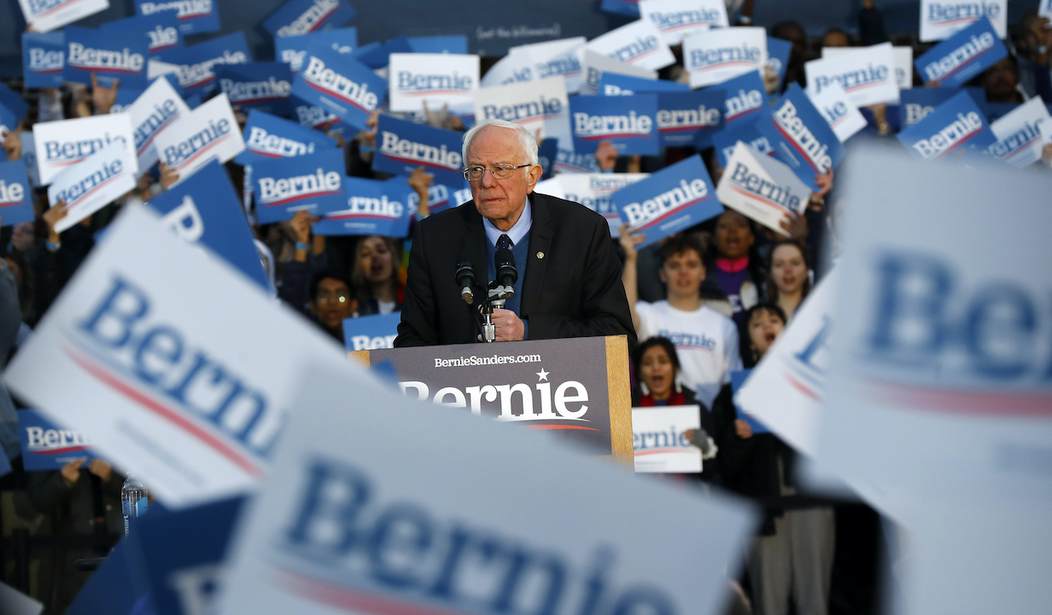This is it, folks. I mean, if Bernie Sanders wants to stay in it, he needs to pull off something special tonight, especially in Michigan, a state he won in the 2016 primaries. It was narrow, but he did well with white working-class voters. The problem is that was then, this is now—and those voters are now with Donald Trump. They’re not coming back. Biden is fresh of his Super Tuesday comeback, where he’s projected to carry the state, nabbing 70-80 of its delegates and truly putting this race out of reach for the Sanderista insurgency.
As of now, FiveThirtyEight has Biden clinching some 59 percent of the vote. As they put it, they ran scores of simulations and in 80 percent of them, Biden nabs 52-65 percent of the vote. Out of the 125 delegates at stake tonight, 43 are based on the total vote of the primary and the remaining 82 are allocated based on congressional districts.
Yet, Michigan is high noon for Sanders for a simple reason: those white working-class voters. And there’s another cause for concern. Commentators have noted the very small timeframe to turn this primary contest around. As this contest heads east, Sanders’ investment in outreach among Latinos depreciates immensely. They’re a smaller share of the vote and score cannot even vote in the closed Democratic primaries; large swaths of young Latinos are independents. In Michigan, that’s especially the case concerning their share of the vote. Also, the black vote is bound to go for Biden, along with suburban voters, repeating the trend that catapulted the former vice president to the top the heap and ripped the frontrunner crown from Bernie (via NYT):
Mr. Sanders has so far failed to match his 2016 strength across the white, working-class North this year, and that suggests it will be hard for him to win Michigan.
This pattern has held without exception this primary season. It was true in Iowa and New Hampshire against Pete Buttigieg and Amy Klobuchar. It was true in Maine, Minnesota, Massachusetts and even Vermont on Super Tuesday against Mr. Biden.
Over all, Mr. Biden defeated Mr. Sanders by 10 points, 38 percent to 28 percent, in counties across Maine, Minnesota and Massachusetts where white voters made up at least 80 percent of the electorate and where college graduates represented less than 40 percent of the electorate. According to the exit polls, Mr. Biden was tied or ahead among white voters in every state east of the Mississippi River on Super Tuesday.
This is a marked departure from 2016. Back then, Mr. Sanders tended to excel among white, working-class and rural voters across the North. This made Michigan, where white voters represent a well-above-average share of the Democratic electorate, one of his stronger states. He dominated in Michigan’s small towns and rural areas, losing only in few counties that tended to have older voters.
It is hard to say why Mr. Sanders has faltered among these voters, given the consistency of his message and his improved name recognition. One possibility is that many of his 2016 supporters were casting protest votes against Hillary Clinton. Another possibility is that many former supporters of Mr. Sanders ultimately backed the president and are now lost to the Democrats.
Whatever the cause, Mr. Sanders has often made up for losses in white, working-class areas this year with gains among Latino voters and white voters who live in left-liberal areas. In a sense, he has traded strength in states like Maine and Minnesota for strength in California. This is a bad trade in Michigan, where Latino voters make up only a sliver of the Democratic electorate. It may be an even worse trade in Michigan than it was in Minnesota or Maine, since there are relatively few overwhelmingly Democratic left-liberal enclaves akin to Minneapolis or Portland, Maine. Only Ann Arbor and Lansing fall into a similar category.
There are few obvious opportunities for Mr. Sanders to make up ground in Michigan. It has an above-average black population, and Mr. Biden will most likely win black voters by a comfortable margin, even if a more modest one than in the South. The suburbs around Detroit are not likely to be particularly favorable for Mr. Sanders, either. He lost suburban Oakland and Macomb Counties in 2016, and he has consistently struggled in affluent suburbs this cycle.
Recommended
Sanders would still need to change the race to his favor. In general there are three ways: debates, results, negative Biden coverage. None look promising for Sanders before Michigan, and a loss there would risk turning 'results' into a negative rather than a positive.
— Nate Cohn (@Nate_Cohn) March 8, 2020
With that in mind, Team Sanders is making the only/correct play by going negative on Biden before Michigan. Attacking him on Social security and so on. Will it be enough, on time? I doubt it. But it's about all they can do before the next debate
— Nate Cohn (@Nate_Cohn) March 8, 2020
If they can avoid a humiliating result on 3/10 in MI/ND/WA/ID, then that next debate, pre-FL/IL/OH/AZ gives them their moment to try and more fundamentally change the race. It might be too late at that point, and FL is going to be a landslide. But AZ/IL aren't huge stretches
— Nate Cohn (@Nate_Cohn) March 8, 2020
Based on Twitter conduct, Team Sanders seems to be edging awfully close to staking the race on whether Biden can hold his own in a on-one-one debate. Without weighing in on the likelihood of that, it does seem fair to say that it might give voters pause if he couldn't
— Nate Cohn (@Nate_Cohn) March 8, 2020
The question is if Sanders will even make it to the next debate. He's a revolutionary. Even if he gets his clock cleaned tonight, safe bet he'll try to take one last stab at Joe, though with questions as to why he's carrying on this effort. He has weaker support from his base and now with reduced support among white working-class voters, the game is truly over.
If the Biden scooter keeps trucking along, it’s estimated that he will lock up a majority of the delegates by April. Nate Cohn tried to make a case for a Bernie comeback, but it’s undeniable to leave out the fact that Biden seems to have this sewn up, quite the turnaround from two weeks ago when many, including myself, were writing his 2020 epitaph. There’s just not much ground left for him to maneuver. A lot of contests after tonight are prime Biden country. Nate Silver gamed out three scenarios for how the next two weeks can go—and all of them aren’t too Bernie friendly:
Anyway, our model has finally seen enough data and thrown the towel in on being conservative now gives Biden an 18-point lead in national polls. That closely matches the 4 polls (Quinnipiac: Biden +19, Ipsos: +17, CNN: +16, Morning Consult +16) since Warren exited the race.
— Nate Silver (@NateSilver538) March 9, 2020
That's quite a bit larger than the lead Obama had vs. Clinton in 2008, which was generally in the mid-high single digits post-Super Tuesday, or that Clinton had over Sanders in 2016, which hovered between 8 and 12 points or thereabouts.
— Nate Silver (@NateSilver538) March 9, 2020
Just to emphasize how quickly Bernie needs to turn this around. If our projections thru 3/17 (next Tuesday) are right, the delegate count at that time would be Biden 1317, Sanders 992, other 139, with 1531 pledged delegates unallocated.
— Nate Silver (@NateSilver538) March 9, 2020
If that holds, Sanders would then have to win *65%* of remaining delegates to earn a majority, which is roughly equivalent to beating Biden by 30 points. In fact, probably more than that, because the states that come after 3/17 (e.g. GA, PA, NJ, MD) are mostly good for Biden.
— Nate Silver (@NateSilver538) March 9, 2020
Unless something big changes, things will get very out of hand for Sanders very soon. In states that have already voted, he currently trails Biden by around 80 delegates based on results as reported as of this morning. (That deficit that may expand as California continues counting its vote — late-counted ballots have been more favorable for Biden than the ones counted on election night — but leave that aside for now.) Then, if our projections are exactly right tonight, Biden would net another 85 delegates, putting him 165 delegates ahead overall.
But still bigger problems await Sanders in the March 17 states and in Georgia on March 24. These states have huge numbers of delegates and some of them — Florida and Georgia in particular — are projected as big Biden wins. The model currently has Biden gaining a net of 226 delegates on Sanders in the states and territories that vote from March 14 through March 24.
That would give Biden an advantage of 391 delegates — which would be essentially insurmountable barring extraordinary contingencies. Sanders would have to win around 69 percent of the remaining delegates from that point forward to claim a majority of pledged delegates, which would equate to beating Biden by 35 or 40 percentage points in the remaining states. A delegate plurality would be almost-as-daunting, requiring Sanders win 64 percent of the remaining delegate haul.
Yikes. Well, it seems a large share of Democrats, especially black voters, are just not into left-wing revolutionary utopias. Also, be mindful of the exit polls with Michigan’s absentee voting laws. Stay tuned. It’s now 'do or die' for the Bernie bros tonight.
Apparently the exit polls from Michigan tonight only include in-person voters, not absentee voters. With absentee voting way up in Michigan this year (perhaps around half the vote?) that basically makes them unusable.
— Nate Silver (@NateSilver538) March 10, 2020
In 2016, there was a fairly significant, Michigan-specific, late surge of Google search interest in Sanders, something that often precedes candidates over-performing their polls. We are not seeing anything like that today. https://t.co/Ww84WLBoNZ pic.twitter.com/YGkhyG5Hm1
— Nate Silver (@NateSilver538) March 10, 2020
























Join the conversation as a VIP Member